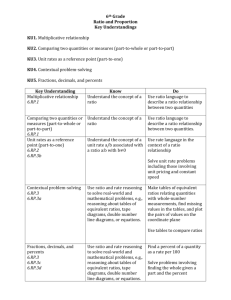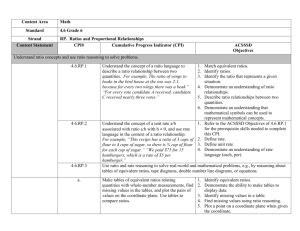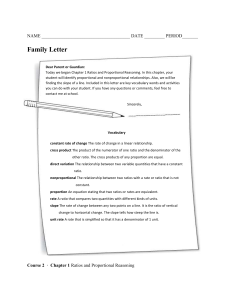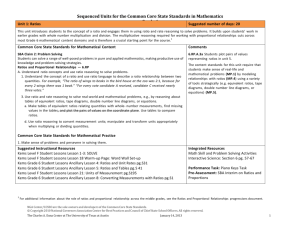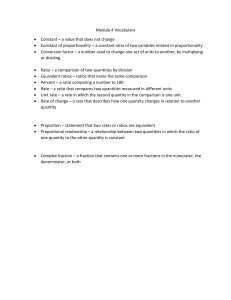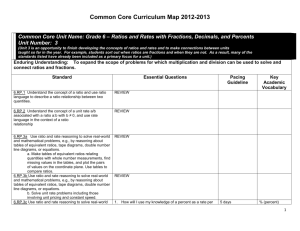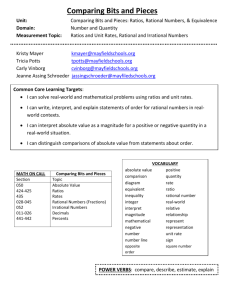6th Math Unit 7 - Livingston County School District
advertisement
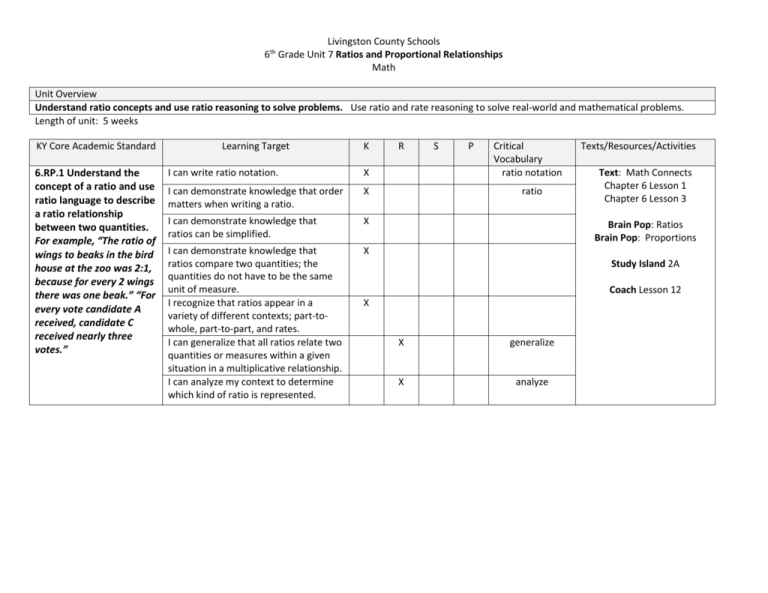
Livingston County Schools 6th Grade Unit 7 Ratios and Proportional Relationships Math Unit Overview Understand ratio concepts and use ratio reasoning to solve problems. Use ratio and rate reasoning to solve real-world and mathematical problems. Length of unit: 5 weeks KY Core Academic Standard 6.RP.1 Understand the concept of a ratio and use ratio language to describe a ratio relationship between two quantities. For example, “The ratio of wings to beaks in the bird house at the zoo was 2:1, because for every 2 wings there was one beak.” “For every vote candidate A received, candidate C received nearly three votes.” Learning Target K I can write ratio notation. X I can demonstrate knowledge that order matters when writing a ratio. X I can demonstrate knowledge that ratios can be simplified. X I can demonstrate knowledge that ratios compare two quantities; the quantities do not have to be the same unit of measure. I recognize that ratios appear in a variety of different contexts; part-towhole, part-to-part, and rates. I can generalize that all ratios relate two quantities or measures within a given situation in a multiplicative relationship. I can analyze my context to determine which kind of ratio is represented. X R S P Critical Vocabulary ratio notation ratio Texts/Resources/Activities Text: Math Connects Chapter 6 Lesson 1 Chapter 6 Lesson 3 Brain Pop: Ratios Brain Pop: Proportions Study Island 2A Coach Lesson 12 X X generalize X analyze 6.RP.2 Understand the concept of a unit rate a/b associated with a ratio a:b with b ≠ 0, and use rate language in the context of a ratio relationship. For example, “This recipe has a ratio of 3 cups of flour to 4 cups of sugar, so there is 3/4 cup of flour for each cup of sugar.” “We paid $75 for 15 hamburgers, which is a rate of $5 per hamburger.” 6.RP.3 Use ratio and rate reasoning to solve realworld and mathematical problems, e.g., by reasoning about tables of equivalent ratios, tape diagrams, double number line diagrams, or equations. a. Make tables of equivalent ratios relating quantities with wholenumber measurements, find missing values in the tables, and plot the pairs of values on the coordinate plane. Use tables to compare ratios. b. Solve unit rate problems including those involving unit pricing and constant I can identify and calculate a unit rate. X rate Text: Math Connects Chapter 6 Lesson 2 Study Island B4 I can use appropriate math terminology as related to rate. X I can analyze the relationship between a ratio a:b and a unit rate a/b where b ≠ 0. X I can make a table of equivalent ratios using whole numbers. X I can find the missing values in a table of equivalent ratios. X I can plot pairs of values that represent equivalent ratios on the coordinate plane. X I can demonstrate knowledge that a percent is a ratio of a number to 100. X I can find a % of a number as a rate per 100. X I can use tables to compare proportional quantities. Coach Lesson 14 Text: Math Connects Chapter 6 Lesson 2 Chapter 6 Lesson 4 Chapter 6 Lesson 6 Chapter 7 Lesson 1 ? Study Island 2B Study Island 2C Study Island 2 D Coach Lesson 13 Coach Lesson 14 Coach Lesson 15 Coach Lesson 16 Brain Pop: Distance Rate and Time Brain Pop: Percents X speed. For example, if it took 7 hours to mow 4 lawns, then at that rate, how many lawns could be mowed in 35 hours? At what rate were lawns being mowed? c. Find a percent of a quantity as a rate per 100 (e.g., 30% of a quantity means 30/100 times the quantity); solve problems involving finding the whole, given a part and the percent. d. Use ratio reasoning to convert measurement units; manipulate and transform units appropriately when multiplying or dividing quantities. I can solve real-world and mathematical problems involving ratio and rate. (e.g., by reasoning about tables of equivalent ratios, tape diagrams, double number line diagrams, or equations. ) X I can apply the concept of unit rate to solve real-world problems involving unit pricing. X I can apply the concept of unit rate to solve real-world problems involving constant speed. X I can solve real-world problems involving finding the whole, given a part and a percent. X I can apply ratio reasoning to convert measurement units in real-world and mathematical problems. X I can apply ratio reasoning to convert measurement units by multiplying or dividing in real-world and mathematical problems. X Common Assessments Developed (Proposed Assessment Dates): HOT Questions:
